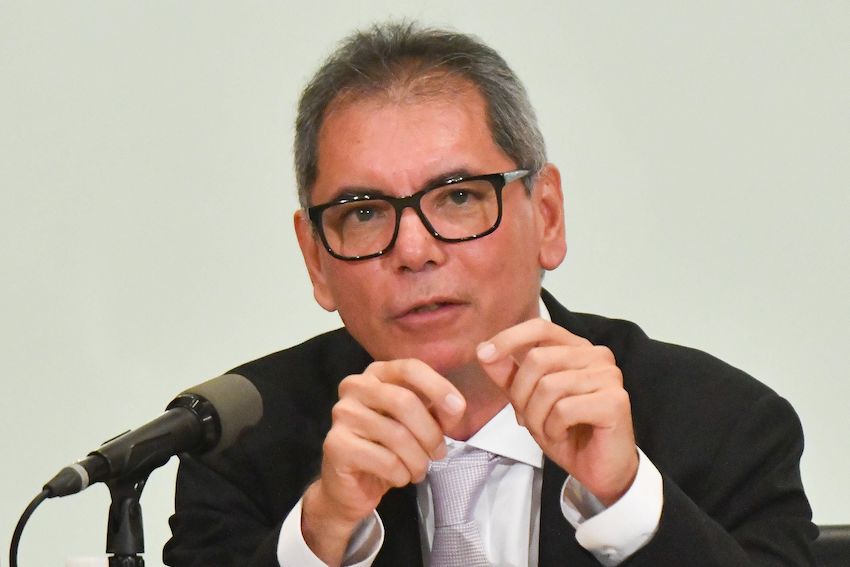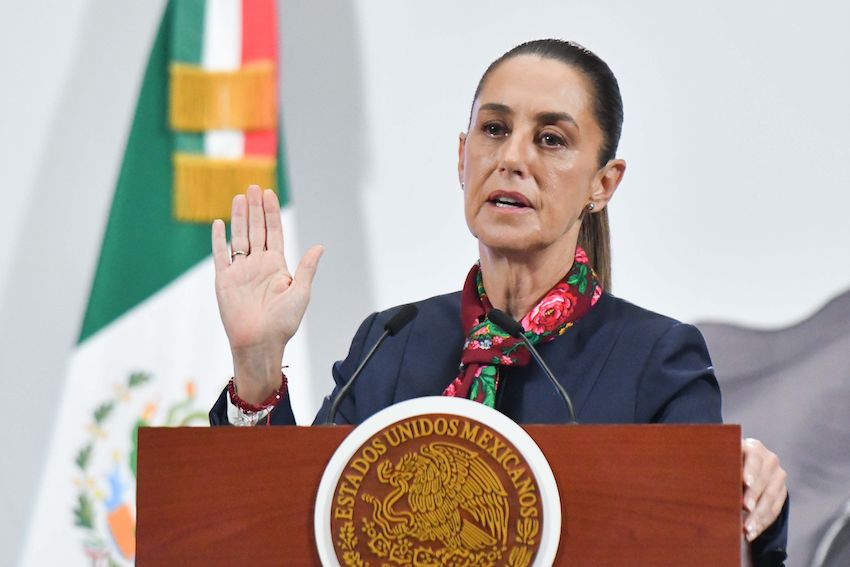Finance Ministry unveils 10 trillion-peso budget with 18% increase to welfare spending
Mexico’s federal government has proposed a 2026 budget of just under 10.2 trillion pesos, a 5.9% increase compared to 2025.
Finance Minister Edgar Amador presented the 10.19 trillion-peso (US $547.44 billion) spending proposal in a speech to the Chamber of Deputies on Monday night.
“The 2026 Economic Package is a roadmap to build a stronger, more competitive, and fairer Mexico. At its center is the conviction that guides our government: ‘For the good of all, the poor come first.’ With this vision, public finances become a tool to reduce inequalities, expand opportunities, and ensure that growth reaches every region,” Amador said.
The 2026 budget proposal requires approval from the Chamber of Deputies, which is dominated by the ruling Morena party and its allies.
Where will the money go?
As Amador indicated, providing support for Mexico’s most disadvantaged citizens is a key priority of the federal government. The main way that support is provided is through government welfare programs, including three new ones created by the almost one-year-old administration of President Claudia Sheinbaum.
The 2026 Economic Package proposes spending of 987.16 billion pesos (US $52.96 billion) on welfare programs, an increase of 18% compared to this year. The proposed outlay is equivalent to 3% of Mexico’s GDP.
More than half the proposed welfare budget is slated to be used to pay pensions to Mexicans aged 65 and over.
Carlos Slim says it’s ‘totally irrational’ in remarks on government welfare spending
Among the other welfare programs that will be funded with the proposed outlay of almost 1 trillion pesos in 2026 are the Youths Building the Future apprenticeship scheme, the Sowing Life tree-planting initiative, the Rita Cetina scholarship scheme for public school students and the Wellbeing pension scheme for women aged 60 to 64.
The Finance Ministry anticipates that 82% of Mexican families will directly benefit from welfare programs in 2026.
The Mexican government’s outlay on welfare programs has increased significantly in recent years. The proposed spending in 2026 is more than three times higher than the outlay in 2019, the first full year of the six-year term of former president Andrés Manuel López Obrador (AMLO).
The provision of welfare programs — cash transfers in many cases — is a key reason why Sheinbaum and the ruling Morena party are so popular, especially in Mexico’s poor southern states. The president has cited the distribution of government resources in the form of welfare as a key reason why more than 13 million people exited poverty between 2018 and 2024.
Among the other spending proposals outlined in Mexico’s 2026 Economic Package are:
- An allocation of 247.23 billion pesos (US $13.26 billion) to Pemex, Mexico’s heavily indebted state oil company. An additional 263.5 billion pesos will be allocated to Pemex to cover its 2026 debt expenses. (The government is aiming for Pemex to become self-sufficient by 2027.)
- An allotment of 104.57 billion pesos to new rail projects.
- Allotments to existing railroads, including 30 billion pesos for the Maya Train.
- An allocation of 61.09 billion pesos to the state-owned Federal Electricity Commission.
- A 27.72-billion-peso outlay on highway and road projects.
- An investment of 25 billion pesos in the Isthmus of Tehuantepec trade corridor.
- An allocation of 20.76 billion pesos for water infrastructure projects.

Around 2.4 trillion pesos is slated to go to government departments, including large allocations to the Public Education Ministry (513 billion pesos), Energy Ministry (267.4 billion pesos), National Defense Ministry (170.7 billion pesos), Health Ministry (66.8 billion pesos), Navy Ministry (65.9 billion pesos) and Security Ministry (60.1 billion pesos).
Mexico’s states and municipalities are slated to receive 2.58 trillion pesos in funding, while 1.26 trillion pesos would cover the salaries of government bureaucrats in 2026.
Around 1.64 trillion pesos is slated to go to the repayment of government debt.
The Finance Ministry said in a statement that the 2026 Economic Package is “a proposal of economic policy focused on guaranteeing welfare programs, health care, education and social housing while promoting productive activity through public investment in strategic programs that boost [the] Plan Mexico [industrial policy], under a vision of development based on well-being and humanism.”
Anticipated revenue in 2026
The Finance Ministry anticipates revenue of 8.72 trillion pesos (US $467.6 billion) in 2026, including 5.83 trillion pesos from tax collection. That level of income would represent year-over-year growth of 6.3%.
Amador said that tax collection is expected to increase 5.7% annually in 2026 to reach a record high of 15.1% of GDP.
The Finance Ministry anticipates that the federal government and Pemex will receive 1.2 trillion pesos in oil-related revenue next year.
The Finance Ministry said that the government is aiming to “strengthen tax collection efficiency,” explaining that it intends to use a range of “mechanisms” to prevent, detect and sanction tax evasion. The government is also seeking to increase tax collection through the modernization of systems used in customs.
In addition, the 2026 budget proposal outlines new so-called “healthy taxes” — i.e. higher taxes on products such as sugary beverages, video games and nicotine pouches. The aim of the proposed tax increases is to reduce the use of such products. Lower consumption of soft drinks and tobacco would “counteract the budgetary effects associated with the treatment of diseases linked to the consumption of these products,” according to the Finance Ministry.
NUEVO IMPUESTO A VIDEOJUEGOS VIOLENTOS ES POR SEGURIDAD, DEFIENDE SHEINBAUM
El Paquete Económico 2026 levantó polémica por proponer un impuesto especial a los videojuegos con contenido violento.
Al ser cuestionado, Claudia Sheinbaum aseguró que es parte de la estrategia de… pic.twitter.com/OLk0zPWe9e
— Juan Ortiz
(@Juan_OrtizMX) September 9, 2025
The budget proposal said that Mexico’s General Import Tax would be reviewed to encourage domestic production and development, but no additional detail was provided.
It appears likely that Mexico will raise tariffs on imports from China and other countries with which it doesn’t have a free trade agreement.
Economic forecasts for 2026
A number of economic forecasts are included in the federal government’s 2026 budget proposal. They include:
- Economic growth in the range of 1.8% to 2.8% in 2026.
- Annual headline inflation of 3% at the end of next year.
- A budget deficit of 4.1% of GDP in 2026.
- Public debt equivalent to 52.3% of GDP.
- A USD:MXN exchange rate of 18.9 at the end of 2026.
- A Bank of Mexico interest rate of 6% at the end of next year.
A budget deficit of 4.1% would represent a decrease compared to the projected 4.32% deficit at the end of this year. The deficit reached a record high of 5.7% of GDP in 2024.
The Finance Ministry said that the projected downward “adjustment” in the budget deficit will not only permit the maintenance of a “stable public debt trajectory,” but also “offer certainty to the population, markets and the international community about the commitment of the government of Mexico to the fiscal sustainability of the country.”
Gabriela Siller, director of economic analysis at Banco Base, said on X that “efforts to reduce the deficit are continuing,” but asserted that “the assistance for Pemex and the rigidity of expenditure in areas such as priority [welfare] programs, pensions and the financial costs of debt drown public finances.”
In another post she noted that the proposed budget includes “a transfer of 263.5 billion pesos to Pemex” to pay down the state oil company’s debt.
“This is equivalent to 3.02% of [anticipated] budgetary income in 2026 and 4.51% of tax income,” Siller said.
The Finance Ministry’s predicted economic growth in 2026 is above the forecasts of both the International Monetary Fund and the Bank of Mexico. The IMF is forecasting 1.4% growth in Mexico in 2026, while the Bank of Mexico sees a 1.1% expansion.

Amador said that “although global uncertainty persists” — in no small part due to the U.S. government’s unpredictable protectionist agenda — “it is expected to moderate over the course of 2026.”
“This more favorable environment, together with public spending focused on social programs and investment projects that have positive effects on aggregate demand, … supports a prudent growth forecast for the coming year,” he said.
Amador also said that the international environment “opens up opportunities that we must seize.”
Most goods made in Mexico can still enter the United States tariff-free thanks to the USMCA free trade pact. That gives Mexico a comparative advantage over other countries when it comes to attracting foreign investment, which reached a record high in the first half of 2025. Mexico’s proximity to the U.S. — the world’s largest economy — as well as its relatively affordable labor costs and availability of skilled workers also make it an attractive investment destination.
A 3% inflation rate would be on par with the Bank of Mexico’s target. Mexico’s annual headline inflation rate was 3.57% in August.
A 6% interest rate at the end of next year would be 175 basis points lower than the current rate of 7.75%.
Sheinbaum: ‘Fundamental principle’ of proposed budget is ‘republican austerity’
In a letter sent to Congress, Sheinbaum said that the “fundamental principle” of the 2026 Economic Package is “republican austerity” — i.e. “the efficient and responsible use of public resources.”

The president also said that “an inclusive and honest government is key to recovering citizens’ confidence,” which she asserted was “eroded for decades by neoliberal practices.”
She said that an inclusive and honest government is also required to “build prosperity from below.”
Sheinbaum also stressed that her government remains committed to “the fight against corruption.”
Like her predecessor, the president seeks to be a champion of personal austerity. One example of that is her commitment to traveling on commercial airlines, including on international trips.
After a number of Morena party politicians and officials, including one of AMLO’s sons, came under fire for their luxurious international travel earlier this year, Sheinbaum urged politicians to live modestly, and reiterated her view that “there can’t be a rich government with a poor people.”
With reports from El Financiero, El Economista, Expansión, La Jornada and Reuters
The post Finance Ministry unveils 10 trillion-peso budget with 18% increase to welfare spending appeared first on Mexico News Daily

Comments
Post a Comment